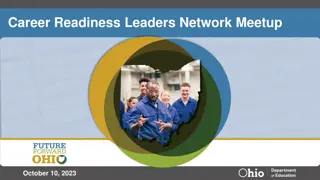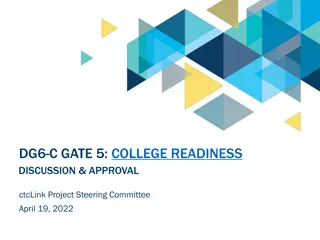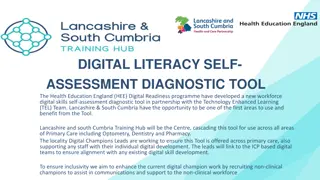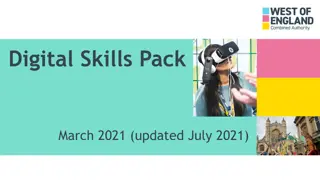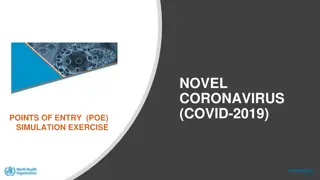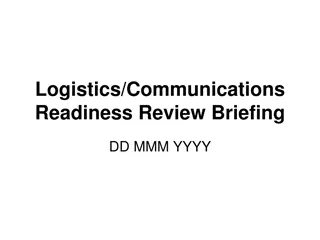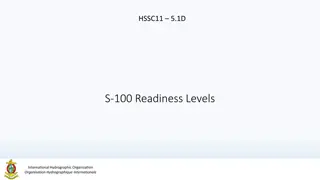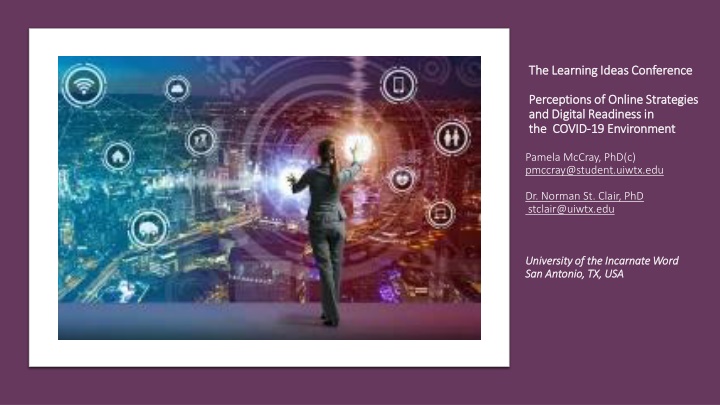
Perceptions of Online Strategies and Digital Readiness in the COVID-19 Environment
This research explores the impact of COVID-19 on graduate students, faculty, and administrators in higher education, focusing on online strategies and digital readiness. Challenges faced, institutional responses, and implications are discussed.
Download Presentation

Please find below an Image/Link to download the presentation.
The content on the website is provided AS IS for your information and personal use only. It may not be sold, licensed, or shared on other websites without obtaining consent from the author. If you encounter any issues during the download, it is possible that the publisher has removed the file from their server.
You are allowed to download the files provided on this website for personal or commercial use, subject to the condition that they are used lawfully. All files are the property of their respective owners.
The content on the website is provided AS IS for your information and personal use only. It may not be sold, licensed, or shared on other websites without obtaining consent from the author.
E N D
Presentation Transcript
The Learning Ideas Conference The Learning Ideas Conference Perceptions of Online Strategies Perceptions of Online Strategies and Digital Readiness in and Digital Readiness in the the COVID COVID- -19 19Environment Environment Pamela McCray, PhD(c) pmccray@student.uiwtx.edu Dr. Norman St. Clair, PhD stclair@uiwtx.edu University of the Incarnate Word University of the Incarnate Word San Antonio, TX, USA San Antonio, TX, USA
Introduce the research team Introduce the topic and research problem Overview Context Purpose, scope, and audience Research question, design, and methodology Findings Conclusions, implications, recommendations, and next steps
Pamela McCray, MBA, PhD(c) PhD(c) Valentina Rada, MBA, PhD(c) Research Team Steven Szeszko II, MS, PhD(c) Norman St. Clair, PhD Kevin B. Vichcales, PhD
The impact on graduate students, faculty, and administrators as educational institutions balance redesign strategies to meet stakeholder needs while transitioning to a blended onsite and digital learning environment. Topic and Research Problem Problem: COVID-19 forced institutes of higher education into a sudden shift requiring remote teaching and learning -- 1.2 billion learners, over 68% of the world's total enrolled learners, were affected globally (Kabir, 2020). 19.4 million student in higher education, 3.1 million in graduate education (NCES.ed.gov, 2022). student in higher education, 3.1 million in graduate education (NCES.ed.gov, 2022). 19.4 million Institutional Readiness Challenges Graduate Student Readiness Challenges Faculty Readiness Challenges
School of Education Graduate Studies Private Catholic University in South Central Texas Hispanic Serving Institution with 19% International Student Population (14% International within Graduate and Doctoral Program) 86% Non-traditional Graduate Students (working adult learners) Context Graduate and Doctoral Students, Graduate and Doctoral Faculty, and Leadership in the School of Education Graduate Studies Institutional Leadership (Administrators) Sudden Shift from In-person Learning Modality to Remote, Hybrid, and Hy- flex: March of 2020 to present
Administrators (leaders), graduate and doctoral faculty, course designers, graduate student support resources, and graduate adult student learners using blended in-person, hybrid, and hy-flex modalities to create, deliver and use course content and instruction for teaching and learning. Audience
The purpose of this qualitative, instrumental case study was to explore the experiences and insights of key stakeholders (graduate students, graduate and doctoral faculty, and administrators in the school of education graduate studies) about integrating and relying on a combination of online and blended strategies for teaching and learning during the COVID-19 Emergency Remote Training (ERT) and the period immediately following as some students started to return to on-site campus classroom environments. Purpose and Scope This study aimed to explore participants' perspectives on effective institutional preparation and readiness, instructional support, training, and strategies to ensure quality instruction and learning at one private Catholic University located in San Antonio, TX.
Primary Research Question, Design & Methodology PRQ: What were the perceptions and adjustments of graduate students, faculty, and administrators to the rapid transition of moving from face-to- face to remote and blended modalities for teaching and learning in the COVID-19 environment? Design: Instrumental Case Study Stake's (1995) framework for a qualitative instrumental case study Saldana s coding strategies (2009) Miles and Huberman's (2020) code-to-theory approach for data collection, analysis, and interpretation of our findings to create a theoretical framework grounded in the data
Study Findings Key Themes: Lack of faculty readiness, acceptance, and adaptability Need for more investment and training to ensure sustainable quality of classroom technology and instructor effectiveness in hybrid modalities Graduate students support needs for academic success Graduate Students expectations of faculty readiness
My first year began in the pandemic, so I never got to experience in-person classes. So shifting to in-person after a year of on-line is overwhelming (Student Janis, 2021). Conceptual patterns: Instructors engaging in multiple modalities without clear direction, student confusion and frustration with inconsistencies, administrators concerned about how lack of consistency impacts student learning Shifting teaching modalities and confusion (category) Theme 1: Lack of faculty readiness, acceptance, and adaptability anytime an institution develops a one size fits all solution it s going to be problematic. It s a mistake for the University to get its instructors to become masters of online instruction (Faculty Dr. G, 2021). Conceptual patterns: Faculty acceptance and adoption of new LMS and new teaching technologies, additional instructor workload burden and stress, limited skills and proficiency using new technologies Faculty technology acceptance and adoption (category) Administrators must ensure the University has the right technology platform, support, training, and funding (Administrator Randy, 2021). Conceptual patterns: Multiple factors: standardized LMS not mandated, lack of instructor training and operational support for new platforms and in-class technology, limitations in combining students in a hybrid classroom environment Educational infrastructure and operational support (category)
how can we use the [classroom] gadgets to support a smooth transition for physical presence or an online platform that all can benefit from (Student Michael, 2021). Conceptual patterns: Challenges with remote learning related to technology and tools. Difficulty of using classroom technology for seamless experiences with in-person and remote students, the technology platform should provide an engaging and effective learning experience for all students. Theme 2: Technology (category) Investment and training to ensure sustainable quality of classroom technology and instructor effectiveness in hybrid modalities provide faculty with support resources that are readily available who are technology experts that can help faculty learn and embrace the new capabilities. Faculty should not have to deal with classroom technology issues (Faculty Dr. O, 2021). Conceptual patterns: Importance of effective communications, training, and support to transition to new classroom technology platforms, readily available technical support for faculty, use of best practices for effective learning (pedagogy/andragogy) for hybrid environments. Prepared faculty (category) Students must feel confident the University has a grand plan and their instructors are well versed in new technology instead of trying to learn it with the students (Administrator James, 2021). Conceptual patterns: Need for institutional top-down strategy to employ multiple modalities that meet the diverse needs of students and instructors, contingency plans to cope with risks and uncertainties, and a University go forward plan for stability. Vision and strategic plan (category)
I think for me, that [changing modalities is] a lot more challenging as an older adult. Flexibility sometimes is a challenge to keep in mind (Student Nicole, 2021). Conceptualpatterns patterns: Adult learners need flexibility and stability to manage work, life, and academic responsibilities, equal levels of learning for F2F and remote learners, exceptional course design that supports multiple modalities and access. Theme 3: Flexibility (category) Graduate students support needs for academic success there s so many differences that can be very stressful for a student that administrators and staff don t see. its important to see differences between age and maturity levels also the importance of awareness with readiness [and] that every student could be facing different challenges (Student Carmen, 2021). Conceptual patterns: Recognizing unique adult learner challenges, finding innovative accommodations regardless of age, background, economics, offering equal levels of learning opportunities for all students. Diverse Student Needs (category) you meet on campus but you bring coffee or bring something to eat. And so we're eating and we're sharing with each other. And so there are opportunities for community building . (Faculty Dr. G, 2021). Conceptual patterns: Graduate students and faculty experienced social interaction challenges in an online environment due to ineffective communication and human interactions, lack of visible body cues and language barriers, gaps in community building and social maintenance activities. Social Interaction (category)
Faculty can't go back to the "old way" of teaching, only F2F, or not be willing to change based on industry trend of moving to digital learning (Faculty, Dr. O, 2021). Conceptual patterns: There is need for innovation and adaptability to embrace changing landscape of digital literacy, adoption of changes require a mind shift for faculty and graduate students, recognition of different levels of literacy: digital immigrants and digital natives. Theme 4: Faculty innovation mindset (category) Graduate students expectations of faculty readiness there should be expectations on both ends [students and faculty] what's required and the guidelines as well give the student a clear understanding of what's expected of them and also for the faculty (Student Janis, 2021). Conceptual patterns: There must be clear student and faculty guidelines and expectations for hybrid environments, the University must have a comprehensive plan for course design, training, and support, faculty buy-in is critical for hybrid environment success. Hybrid Participation Expectations and Etiquette (category)
Literature Support of Study Findings Lack of faculty readiness, acceptance, adaptability Graduate students support needs for academic success COVID-19 was a "black swan" event that forever altered the landscape for adult teaching and learning in higher education. Faculty readiness, acceptance, and adaptability require institutions of higher learning to shift into an acceptance of this new reality by adapting and adopting to new, flexible modalities while striking a balance of readiness, instructional quality, flexibility to remain competitive and relevant (Guppy et al., 2022; Montenegro-Rueda et al., 2021). COVID-19 exposed a shift in how resources need to be prioritized at the institutional level to meet student s support needs for academic success. Proactive emergency planning develops contingencies that include flexible modalities, faculty digital competence, pedagogical best practices, LMS design, and student acclamation (Chen et al., 2022; Oliveira et al., 2021). Universities must have the right affordances in place before a crises, such as institutional wide platforms and competency training for faculty and students. A pathway shift is needed to find a new normal for the digital university using a blended online/hybrid model. Need for more investment and training ensure sustainable quality classroom technology and instructor effectiveness in hybrid modalities Graduate students expectations of faculty readiness Educational support units within universities can play a critical role along with reexamining institutional policies and structures to support new teaching and learning paradigms (Bo ki , & Hausknecht, 2021). Messaging of a clear plan and vision for students and faculty that includes their voices and addresses students expectations of faculty readiness can inspire trust and confidence (Calderone et al., 2022; David, 2020). Institutional investment into Infrastructure and Support for Faculty and Students, Reference Case Study (Bo ki , & Hausknecht, 2021). Institutional messaging can have an overall positive impact. However, student support and accessible platforms instill confidence (Paliwal & Singh, 2021; Cullinane et al., 2022) Sustainable investments and assessment of classroom technology and instructor effectiveness in hybrid modalities are required for success. All the institutional key stakeholders must be engaged in developing a holistic and effective support system for online/hybrid learning environments.
Recommendations: Administrators, Faculty, Graduate Students Recommendations: Administrators, Faculty, Graduate Students Graduate Students Faculty Administrators
Recommendations Administrators Social Interaction & Diverse Challenges: Social interaction in hybrid modalities Diverse adult learners Inclusive Student & Faculty Needs: Clear Plan & Vision Solicit Feedback Responsive to emerging needs Infrastructure: Technology Operational Support Development Proactive Planning: Contingencies Communication Plan Preparation Students Faculty Support: Academic Support services Tutoring Mental health Accessibility: Course material and technologies available and accessible to all students Course Design: Engagement: Interactive lectures Group projects Collaboration Team teaching Innovative Teaching: Hybrid modalities Immersive learning experiences Training & Resources: Effective online & hybrid modalities Instructional Designers Learning Mgt System use Flexibility: Learner choices on course formats and delivery Effective Communication: Clear expectations Tool Access Timely feedback Best practices for online & hybrid Digital pedagogy
Framework - Comprehensive Institutional Model (CIM) Faculty Review of Student Feedback, Changes and Innovation to Improve Experience Feedback to Administration on Support and Operational Needs Student Feedback and Recommendations Faculty Design Classroom Application and Implementation Student Outcomes University Leadership Administration Administration provides Foundational Institutional Support
Recommendations Administrators Social Interaction & Diverse Challenges: Social interaction in hybrid modalities Diverse adult learners Inclusive Student & Faculty Needs: Clear Plan & Vision Solicit Feedback Responsive to emerging needs Infrastructure: Technology Operational Support Development Proactive Planning: Contingencies Communication Plan Preparation Students Faculty Support: Academic Support services Tutoring Mental health Accessibility: Course material and technologies available and accessible to all students Course Design: Engagement: Interactive lectures Group projects Collaboration Team teaching Innovative Teaching: Hybrid modalities Immersive learning experiences Training & Resources: Effective online & hybrid modalities Instructional Designers Learning Mgt System use Flexibility: Learner choices on course formats and delivery Effective Communication: Clear expectations Tool Access Timely feedback Best practices for online & hybrid Digital pedagogy
NextSteps Test efficacy of Design Based Research CIM Model CIM Model Case Study Additional Case Studies Higher Education Institutions Compare Findings
Thank you! Thank you! Pamela McCray, PhD(c) Pamela McCray, PhD(c) pmccray@student.uiwtx.edu pmccray@student.uiwtx.edu Dr. Norman St. Clair, PhD Dr. Norman St. Clair, PhD stclair@uiwtx.edu stclair@uiwtx.edu University of the Incarnate Word University of the Incarnate Word San Antonio, TX, USA San Antonio, TX, USA
References 1. Adeoyin, O. B., Soykan, E.: Covid-19 pandemic and online learning: The challenges and opportunities. Interactive Learning Environment, (2020). 2. Al-Azawei, A., Parslow, P., Lundqvist, K.: Investigating the effect of learning styles in a blended e-learning system: An extension of the technology acceptance model (TAM). Australian Journal of Education Technology 33, 1 23 (2017). 3. Almahasees, Z., Mohsen, K., Amin, M. O.: Faculty's and students' perceptions of online learning during COVID-19. Frontiers in Education 6, 1-10 (2021). 4. Beteille, T., Ding, E., Molina, E., Pushparatnam, A., Wilichowski, T.: Three principles to support teacher effectiveness during COVID-19. World Bank (2020). 5. Bo ki , N., Hausknecht, S.: Reshaping the educational landscape: During and after the COVID-19 pandemic. Inovacije U Nastavi: asopis Za Savremenu Nastavu 34(4), 36-50 (2021). 6. Cavanaugh, C., Deweese, D.: Understanding the professional learning and support needs of educators during the initial weeks of pandemic school closures through search terms and content use. Journal of Technology and Teacher Education 28(2), (2020). 7. Chen, V., Sandford, A., LaGrone, M., Charbonneau, K., Kong, J., Ragavaloo, S.: An exploration of instructors' and students' perspectives on remote delivery of courses dur-ing the COVID 19 pandemic. British Journal of Educational Technology 53(3), 512-533 (2022). 8. Cheng, G., Chau, J.: Exploring the relationships between learning styles, online partici-pation, learning achievement and course satisfaction: An empirical study of a blended learning course. British Journal of Educational Technology 47, 257 278 (2016). 9. Conrad, C., Deng, Q., Caron, I., Shurska, O., Skerrett, P., Sundararajan, B.: How stu-dent perceptions about online learning difficulty influenced their satisfaction during Canada's Covid-19 response. British Journal of Educational Technology, (2022). 10. Crowe, S., Cresswell, K., Robertson, A., Huby, G., Avery, A., Sheikh, A.: The case study approach. BMC medical research methodology, (2011). 11. Dam a, C., Langford, M., Uehara, D., Scherer, R.; Teachers' agency and online educa-tion in times of crisis. Computers in Human Behavior 121(106793), 1-16 (2021). 12. Dworkin, S.L., Sample size policy for qualitative studies using in-depth interviews. Ar-chives of Sexual Behavior 2012(41), 1319-1320 (2012). 13. Foerderer, M., Hoffman, S., Schneider, N., Prichard, J. R.: Predicting levels of student satisfaction during COVID-19. Educause Review, (2021). 14. Garc a-Morales, V. J., Garrido-Moreno, A., Mart n-Rojas, R.: The transformation of higher education after the COVID disruption: Emerging challenges in an online learn-ing scenario. Frontiers in Psychology 12, (2021).
References 15. Guppy, N., Verpoorten, D., Boud, D., Lin, L., Tai, J., Bartolic, S.: The post COVID 19 future of digital learning in higher education: Views from educators, students, and other professionals in six countries. British Journal of Educational Technology, (2022). 16. Gurukkal, R.: Will COVID 19 turn higher education into another mode? Higher Educa-tion for the Future 7, 89 96 (2020). 17. Karakose, T.: The impact of the COVID-19 epidemic on higher education: Opportuni-ties and implications for policy and practice. Educational Process: International Journal 10(1), 7-12 (2021). 18. Miles, M. B., Huberman, A. M., Saldana, J.: Qualitative Data Analysis: A Methods Sourcebook. 4th Edition. Sage Publishing, (2020). 19. Montenegro-Rueda, M., Luque-de la Rosa, A., Sarasola S nchez-Serrano, J. L., Fer-n ndez-Cerero, J.: Assessment in higher education during the COVID-19 pandemic: A systematic review. Sustainability 13(19), (2021). 20. Oliveira, G., Grenha Teixeira, J., Torres, A., Morais, C.: An exploratory study on the emergency remote education experience of higher education students and teachers dur-ing the COVID 19 pandemic. British Journal of Educational Technology 52(4), 1357-1376 (2021). 21. Paliwal, M., & Singh, A.: Teacher readiness for online teaching-learning during COVID 19 outbreak: A study of Indian institutions of higher education. Interactive Technology and Smart Education 18(3), 403-421 (2021). 22. Saldana. J., Omasta, M.: Qualitative Research Analyzing Life. 2nd edn. SAGE, (2022). 23. Stake, R. E.: Qualitative research. Studying how things work. The Guilford Press, (2010;1995). 24. Usher, M., Hershkovitz, A., Forkosh Baruch, A.: From data to actions: Instructors' de-cision making based on learners' data in online emergency remote teaching. British Journal of Educational Technology 52(4), 1338-1356 (2021).
Questions? Discussion: What was your experience with COVID- 19 ERT and now post- COVID adult learning and teaching practices? Can you relate with the study key themes? What other insights or perspective can you share?



